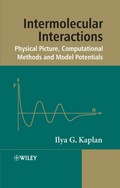Intermolecular Interactions
Physical Picture, Computational Methods and Model Potentials
Wiley Series in Theoretical Chemistry

1. Auflage April 2006
380 Seiten, Hardcover
Wiley & Sons Ltd
Kurzbeschreibung
An update of Theory of Molecular Interactions, Intermolecular Interactions has been completely rewritten to contain all mathematical apparatus needed for its study, as well as a description of principal quantum-mechanical and quantum-chemical methods applied to many-electron systems.
The subject of this book--intermolecular interactions-- is as important in physics as in chemistry and molecular biology. Intermolecular interactions are responsible for the existence of liquids and solids in nature. They determine the physical and chemical properties of gases, liquids, and crystals, the stability of chemical complexes and biological compounds.
In the first two chapters of this book, the detailed qualitative description of different types of intermolecular forces at large, intermediate and short-range distances is presented. For the first time in the literature, the temperature dependence of the dispersion forces is analyzed and it is shown that the famous Casimir-Polder formula for dispersion forces is incorrect at any finite temperature. The author has aimed to make the presentation understandable to a broad scope of readers without oversimplification. In Chapter 3, the methods of quantitative calculation of the intermolecular interactions are discussed and modern achievements are presented. This chapter should be helpful for scientists performing computer calculations of many-electron systems.
The last two chapters are devoted to the many-body effects and model potentials. More than 50 model potentials exploited for processing experimental data and computer simulation in different fields of physics, chemistry and molecular biology are represented. The widely used optimization methods: simulated annealing, diffusion equation method, basin-hopping algorithm, and genetic algorithm are described in detail.
Significant efforts have been made to present the book in a self-sufficient way for readers. All the necessary mathematical apparatus, including vector and tensor calculus and the elements of the group theory, as well as the main methods used for quantal calculation of many-electron systems are presented in the appendices.
All those working on the theoretical and experimental studies of intermolecular interactions in chemistry, physics, biochemistry and molecular biology will find this text of interest and it will appeal to advanced undergraduates, graduates and researchers.
1 Background Knowledge.
1.1 The Subject and its Specificity.
1.2 A Brief Historical Survey.
1.3 The Concept of Interatomic Potential and Adiabatic Approximation.
1.4 General Classification of Intermolecular Interactions.
References.
2 Types of Intermolecular Interactions: Qualitative Picture.
2.1 Direct Electrostatic Interactions.
2.2 Resonance Interaction.
2.3 Polarization Interactions.
2.4 Exchange Interaction.
2.5 Retardation Effects in Long-Range Interactions and the Influence of Temperature.
2.6 Relativistic (Magnetic) Interactions.
2.7 Interaction Between Macroscopic Bodies.
References.
3 Calculation of Intermolecular Interactions.
3.1 Large Distances.
3.2 Intermediate and Short Distances.
References.
4 Nonadditivity of Intermolecular Interactions.
4.1 Physical Nature of Nonadditivity and the Definition of Many-Body Forces.
4.2 Manifestations of Nonadditive Effects.
4.3 Perturbation Theory and Many-Body Decomposition.
4.4 Many-Body Effects in Atomic Clusters.
4.5 Atom-Atom Potential Scheme and Nonadditivity.
References.
5 Model Potentials.
5.1 Semiempirical Model Potentials.
5.2 Determination of Parameters in Model Potentials.
5.3 Reconstructing Potentials on the Basis of Experimental Data.
5.4 Global Optimization Methods.
References.
Appendix 1: Fundamental Physical Constants and Conversion Table of Physical Units.
Appendix 2: Some Necessary Mathematical Apparatus.
A2.1 Vector and Tensor Calculus.
A2.2 Group Theory.
References.
Appendix 3: Methods of Quantum-Mechanical Calculations of Many-Electron Systems.
A3.1 Adiabatic Approximation.
A3.2 Variational Methods.
A3.3 Perturbation Theory.
References.
Index.


